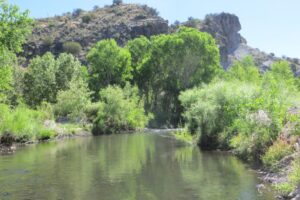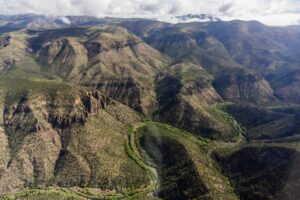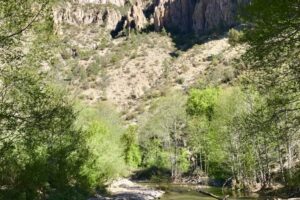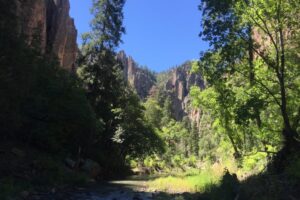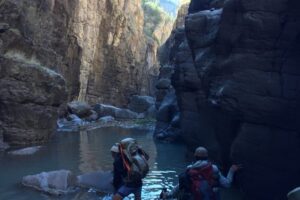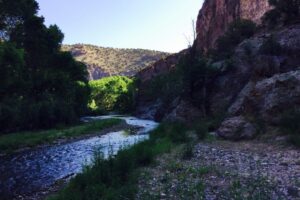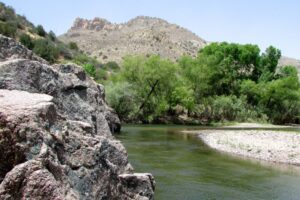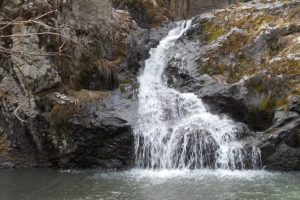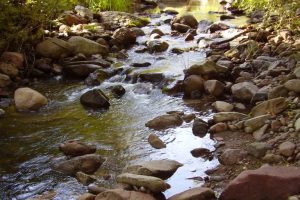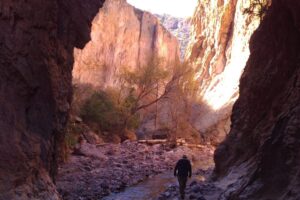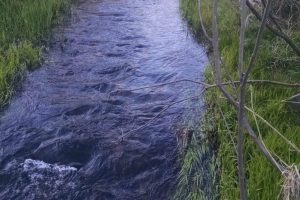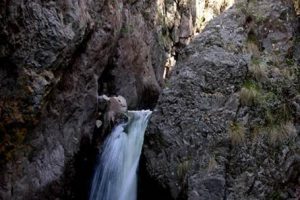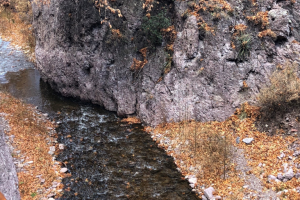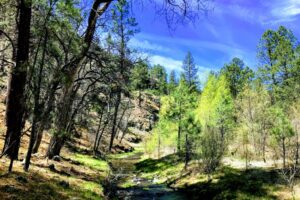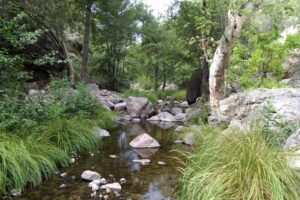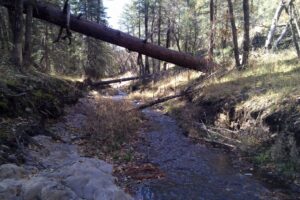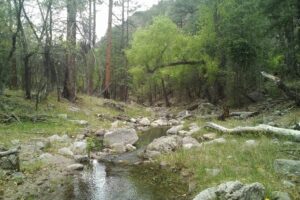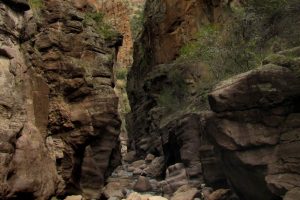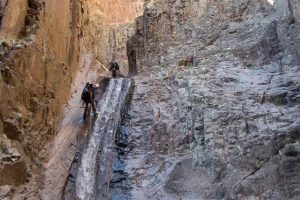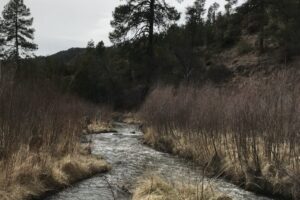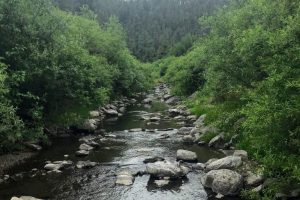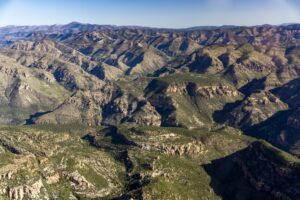Below is a list of Gila and San Francisco river segments that would be protected under Wild and Scenic legislation proposed by community members in Grant and Catron counties.
- Mogollon Creek is completely wild from its headwaters in the Gila Wilderness to the wilderness boundary, and has been at the center of efforts to recover the Gila trout. The Gila trout was federally listed as endangered under the Endangered Species Act of 1973 after decades of conservation efforts by the State of New Mexico to protect and restore the species. In 2006, the Gila trout was down-listed to threatened and now inhabits eleven streams in New Mexico, including Mogollon Creek.
- The main stem of the Gila River provides visitors with a profound sense of solitude. This long, meandering river corridor through the heart of the Gila Wilderness is an assertive landscape, where a combination of aridity and moisture sharpens the steep cliff walls and enhances the smooth riparian belt that surrounds the water. Constant volcanic eruptions from 35 million to 20 million years ago, followed by millennia of weather, pressure, and erosion, are what makes the geology along the Gila River so outstandingly remarkable today. Photo Credit: EcoFlight
- The West Fork of the Gila River deserves protection as a Wild and Scenic river segment. This is one of the most visited locations in the Gila Wilderness, the first wilderness designated in the world. Activities such as multi-day backpacking, day hiking, horseback riding, and pack mule trips are all popular forms of recreation here. Opportunities to hunt and fish are also abundant, given that the West Fork of the Gila River runs through some of the most remote and wildest public lands left in North America.
- The Middle Fork of the Gila River deserves protection as Wild and Scenic due in large part to its cultural and historical significance. Though no one knows when humans first came to live within the Gila region, there’s evidence that humans might have occupied the area as early as 9,500 B.C. At least five known cultures have inhabited what is now the Gila National Forest, including three prehistoric Native American cultures. The most prominent was the Mogollon civilization, which disappeared around the 13th century.
- The Upper San Francisco Box deserves protection under the Wild and Scenic Act. Over millennia, the river has cut a tremendously deep and narrow gorge through this region that stretches 1,000 feet from top to bottom. The box canyon itself is astoundingly constricted and tight, with massive boulder fields, cascading waterfalls and deep pools that stretch for roughly 2 miles. This deep canyon, along with its associated geological wonders and scenery, is unique to the region and the Gila National Forest.
- The Lower San Francisco River Canyon deserves protection under proposed Wild and Scenic legislation for many reasons, including its importance to a variety of fish and wildlife species. This segment of the San Francisco River is designated as critical habitat for the federally endangered loach minnow and spike dace. The waterway is also proposed critical habitat for the threatened narrow-headed gartersnake and the northern Mexican gartersnake.
- The Gila Middle Box deserves protection under proposed Wild and Scenic legislation. The Gila Middle Box lies within the Burro Mountains, which are in the Mexican highland section of the Basin and Range physiographic province in southwestern New Mexico. During the latest Proterozoic and Cambrian eras, the Burro Mountains were uplifted and eroded. The Burro Mountains were either a highland during much of Phanerozoic time, or older sedimentary rocks were eroded before deposition of Cretaceous rocks when seas partially covered the mountain range.
- Holden Prong is another segment that deserves protection under the Wild and Scenic act, in part due to its incredible diversity of fish species. The southernmost location of the threatened Rio Grande cutthroat trout, the Rio Grande sucker and Rio Grande chub can also be found at Holden Prong. This assemblage of fish species is not known to exist anywhere else.
- Las Animas Creek is another segment that deserves protection under proposed legislation to designate portions of the Gila and San Francisco Rivers as Wild and Scenic. This segment is historically significant as the location of a famous battle between the U.S. Army 9th Cavalry Buffalo Soldiers and Victorio’s band of Chiricahua Warm Springs Apache in September of 1879. The site is still considered important by living descendants of the Fort Sill Warm Springs Apache.
- Mineral Creek deserves protection under proposed legislation to designate the Gila and San Francisco Rivers as Wild and Scenic. The scenery in Mineral Creek is outstanding due to the high canyon walls, soaring spires, numerous waterfalls, slot canyons, and riparian vegetation that includes sycamores, box elders, and cottonwoods. These narrow slot canyons are astoundingly constricted and tight and are surrounded by extremely interesting rock formations.
- South Diamond Creek is a popular destination for outdoor recreation. This is just one reason it deserves protection under the Wild and Scenic Act. Located in Catron and Sierra Counties, the Continental Divide National Scenic Trail traverses through the headwaters of South Diamond Creek, providing extensive backpacking, hiking, horseback riding, and pack mule trip opportunities.
- Spruce Creek deserves protection under the Wild and Scenic Act. Located entirely within the Gila Wilderness, this river segment supports the only known surviving population of the Spruce Creek lineage of the Gila trout, which is genetically distinct from all other Gila trout lineages.
- Whitewater Creek deserves protection under the Wild and Scenic Act. Accessed via the Catwalk National Recreation Trail, Whitewater Creek is a popular destination for those interested in 19th century mining history and the associated geology of the region. Each year, thousands of visitors take the thrilling walk along the cool and colorful Whitewater Canyon and many use the pleasant picnicking facilities at the Whitewater Picnic Grounds.
- Black Canyon deserves protection as a Wild and Scenic river segment. The Black Range Crest Trail, which overlaps with the headwaters of Upper Black Canyon, is one of the wildest and most remote places in the Aldo Leopold Wilderness. Here you will find remarkable opportunities for fishing native Gila trout. As an added bonus, you will also find ripe raspberries in August!
- Located entirely within the Gila Wilderness, Turkey Creek is another river segment that deserves protection under the Wild and Scenic Act. Activities such as day hiking, mult-iday backpacking, horseback riding, pack mule trips, hunting, and fishing are popular here, as the segment runs through some of the wildest and most remote public lands left in North America.
- Adjacent to the Aldo Leopold Wilderness, the East Fork of the Mimbres River deserves protection under the Wild and Scenic Act. This segment flows through McKnight Canyon, which features old-growth forest comprised of ponderosa pine, Douglas fir, white fir, Western white pine, quaking aspen, Engelmann spruce, Gambel oak, piñon, alligator juniper, one-seeded juniper, gray oak, scrub live oak and Rocky Mountain maple.
- Located in Catron and Sierra Counties, Taylor Creek deserves protection as a Wild and Scenic segment. Significant cultural resources can be found here, including cliff dwellings, caves and petroglyphs that are comparable to the cultural resources found along the West Fork of the Gila River.
- Sapillo Creek is another segment that deserves protection as Wild and Scenic. Located within the Gila Wilderness, Sapillo Creek is an active area for recovery of the threatened native Gila trout, and the fish is being stocked in this river segment.
- The West Fork of Mogollon Creek deserves protection as Wild and Scenic. This segment carves its way through a deeply incised canyon, with massive mountains in all directions, with cascading waterfalls and swimming pools.
- The East Fork of the Gila River deserves protection under the Wild and Scenic Act. This segment provides anglers with a unique fishing experience due to a population of small-mouth bass that occurs nowhere else.
- Located in the northwest section of the Gila Wilderness, Gilita Creek deserves protection as a Wild and Scenic segment. Gilita Creek is one of eleven streams that features a population of the threatened native Gila trout, and this segment has been at the center of efforts to restore this species for decades.
- Little Creek deserves protection as a Wild and Scenic segment. Located entirely within the Gila Wilderness, Little Creek offers exceptional outdoor recreation opportunities including hiking, backpacking, horseback riding, and pack mule trips. Eight separate trailheads provide remarkable access to this segment.
